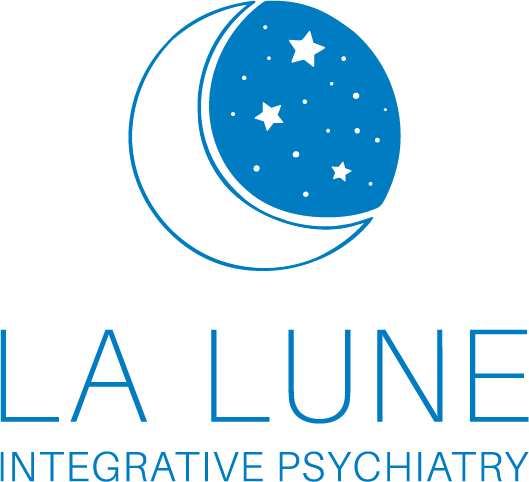Too Much Information: When to Set Boundaries with Social Media and the News
Most of us don’t actually want to delete social media or stop reading the news. We want to stay informed, connected, and engaged — just without the knot in our stomach afterward.
Medically Reviewed by Elita Wong, PMHNP-BC
At La Lune Integrative Psychiatry, we often meet people who describe feeling anxious, distracted, or emotionally “full” — not from their own lives, but from everything they’ve absorbed online. In a world where connection happens through screens, learning when to pause isn’t avoidance — it’s mental hygiene.
The Double-Edged Power of Media
Social media and the news connect us in remarkable ways.
We can witness global events in real time.
Support causes that matter.
Find community during isolation.
Even discover mental health education and resources that didn’t exist a decade ago.
But when exposure is constant — especially to distressing or emotionally charged content — our brains struggle to distinguish between threats we can act on and threats we can only witness.
That can keep the body’s stress system running on overdrive.
When Media Exposure Affects Mental Health
Unchecked, chronic media exposure can intensify or even mimic symptoms of several psychiatric conditions depending on the content:
Generalized Anxiety Disorder (GAD): Constant updates can feed worry loops (“What if this happens next?”).
Major Depressive Disorder (MDD): Repeated exposure to negative or tragic news can heighten feelings of hopelessness or fatigue.
Panic Disorder: Graphic or unpredictable headlines may trigger sudden physical anxiety responses — racing heart, dizziness, chest tightness.
Social Anxiety: Online comparison and judgment loops reinforce self-consciousness and fear of rejection.
Obsessive-Compulsive Disorder (OCD): Compulsive checking for reassurance — refreshing news feeds, doomscrolling — can act as a digital ritual.
Grief and Trauma: Media can re-activate loss or trauma, especially when global crises mirror personal experiences.
Many people have gone into the habit of experiencing media without any limits or filters. Sometimes companies and individuals hand-select media for us that is meant to encourage strong emotional responses and impulses, which can make it harder for us to control what content comes our way.
We only have about two decades of social media in our lives so more commonly agreed upon etiquette, safety, and boundaries are still being shaped. What we can control and understand is how each type of media impacts our mental health and what limits we need to set for ourselves on an individual level.
Finding Healthy Boundaries That Work
You don’t have to quit social media or stop reading the news — but it helps to notice what kind of content, how much of it, and when you’re taking it in. During stressful times, grief, or transition, even ordinary exposure can feel heavier. Awareness, not avoidance, is what keeps connection from turning into overwhelm.
What feels manageable one week might feel draining during periods of loss, burnout, or anxiety. Your nervous system’s capacity changes, and your boundaries can too.
1. Social Media Boundaries
Curate your feed for connection, not comparison.
Limit passive scrolling; engage intentionally (message, comment, create).
Mute or unfollow accounts that trigger anxiety, guilt, or self-criticism.
Try “mindful scrolling”: pause to notice your body — are your shoulders tense, heart rate up? That’s your cue to stop.
2. News Boundaries
Check the news on schedule, not reflexively — e.g., once in the morning, once in the evening.
Choose reputable, balanced outlets; avoid endless commentary loops.
Turn off push notifications that create constant alert states.
After reading a heavy story, ground yourself — stretch, step outside, breathe.
3. Emotional Boundaries
Notice when you’re absorbing emotions that aren’t yours — outrage, fear, despair.
Ask: Is this something I can meaningfully act on right now?
If not, it’s okay to set it down.
4. Relational Boundaries
Discuss digital breaks with partners or friends — agree to “no-scroll zones” during meals or evenings.
Remember: being present with real people restores the same sense of connection we often chase online.
5. Internal Boundaries
Practice self-compassion. You’re not weak for feeling overwhelmed; you’re attuned.
Balance “input” (news, content) with “output” (journaling, art, movement, rest).
Your brain needs quiet moments to process — silence isn’t empty, it’s restorative.
When Overload Becomes a Symptom
Sometimes, the fatigue or anxiety doesn’t fade even after reducing screen time. You may notice:
Persistent worry or irritability
Sleep disturbance
Trouble focusing
Emotional numbness or shutdown
Physical symptoms like headaches, palpitations, or stomach upset
Intrusive or obsessive thoughts
It may be time to reach out for support if media exposure is starting to worsen your depression, anxiety, or obsessive-compulsive symptoms —especially if it’s beginning to affect your relationships, work, or self-care. You don’t have to reach a breaking point before asking for help.
The Integrative Approach
At La Lune Integrative Psychiatry, we treat these modern stress patterns with compassion and evidence-based care — combining psychotherapy, lifestyle interventions (like digital hygiene, nutrition, and sleep regulation), and medication management if clinically indicated.
Our goal isn’t to disconnect you from the world — it’s to help you reconnect with yourself, grounded and clear. Your brain needs some quiet moments to process, integrate, and heal. That’s where resilience begins.
Ready to understand what’s really behind your symptoms?
Book your appointment today to explore personalized, holistic psychiatric care in WA, OR, CO, AZ, and NH.
Disclaimer: This website does not provide medical advice and may be out of date. The information, including but not limited to text, PDFs, graphics, images, and other material contained on this website are for general educational purposes only. No material on this site is intended to be a substitute for professional medical advice, diagnosis, or treatment, and does not create a patient-doctor relationship. Always seek the advice of your qualified healthcare provider with any questions you may have regarding a medical condition, lifestyle or dietary changes, treatments, and before undertaking a new health care regimen. Never disregard professional medical advice or delay in seeking it because of something you have read on this website.





